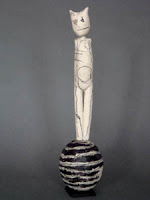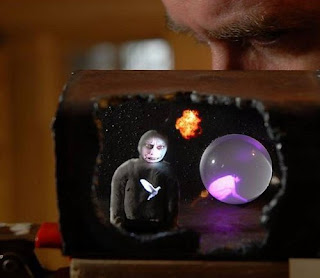>
Class 1125- Using New Technology in Your Artwork – Basic Arduino For Artists

For more info on classes and to pay online- click HERE.
Visiting Artists – Melissa Stern
>
NY- based artist Melissa Stern has been working recently in the glass school. Best know for her mixed media sculptures and drawings, Melissa has expanded her repertoire to include glass.
Melissa’s artwork is deceptive in its playful, childlike quality. Her highly imaginative (and frequently amusing) ceramic sculptures and drawings usually featuring human figures which call to mind sophisticated illustrations for children’s stories. Melissa sees her work removed from specific narrative and functioning instead in terms of psychology and metaphor. As much as we would like a ceramic standing figure–feet nailed to the floor, arms holding aloft a branch upon which large birds perch–to introduce a fascinating if disturbing fable, there is no story to explain it.
Summer in the South, collage, oil paint, pencil, 12 x 9
World View , clay, acrylic, paper, graphite, encaustic, 23″ x 5″ x 5″
Translating her drawn imagery with the use of glass frit powder, Melissa has really taken to the process, making it her own.
Melissa Stern’s fused glass frit components are assembled onto the glass panels she is creating.
Melissa and Tim Tate discuss the development of her panels.
Carving holes, tack-fusing texture, layering images – Melissa will ultimately add other non-glass elements to the glass panels she is creating.
We look forward to seeing the finished works by Melissa! And congratulations, Melissa, on becoming an adjunct professor at Brooklyn College!
Glass Sparks: Tim Tate
>
 Tim Tate photograph by Tom Wolff
Tim Tate photograph by Tom Wolff
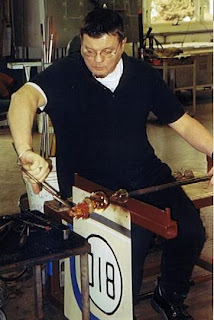
Tim works “off pipe” at Penland, NC
After a personal event sent him to Penland School of Craft for several months, Tim left the concept of technique driven vessels behind, and began his decade long passion for narrative, content driven sculpture. By working with content, Tim had found his voice. With this clarity of focus Tim sought to enhance the position of glass as a sculptural medium to the Washington, DC art scene. Tim’s first step: he founded the Washington Glass School.

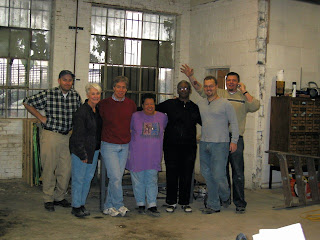
Working with Erwin Timmers and a dedicated group of volunteers, they began by clearing space out of one of DC’s abandoned school buildings that was converted to artist studios. That task was a hard enough start, but after a summer of preparation of the studios, the school was challenged by situations outside if its control. The first class occurred just days after 9/11. Thinking the students would want to cancel after so disturbing an event, Tim called all the students – who unanimously asked for the class to go on. In frightening and unstable times, Tim discovered that people like to work through pressures by creating artwork. The glass school has sought to become the refuge for those seeking artwork as a way to help define and express themselves.
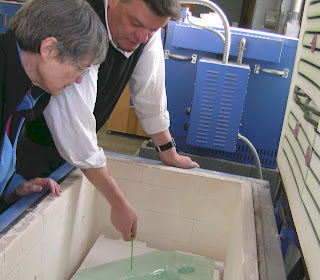
Tim advises a student about a casting technique.
Tim has worked at having the medium of glass evolve in the last decade; taking it from a technique driven vessel approach to the mixed media sculptural material it has become. His pioneering work at integrating contemporary electronics and video medias into traditional craft has brought much attention to his artwork. In 2009, National Public Radio (NPR) had segment about Tim’s work in their “All Tech Considered”
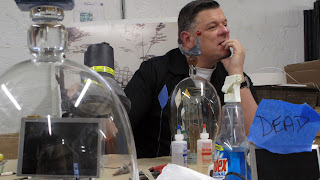 Click HERE to jump to the NPR segment “Tim Tate’s Hi-Tech Art”.
Click HERE to jump to the NPR segment “Tim Tate’s Hi-Tech Art”.
Tim has become an enthusiastic promoter of the medium, finding new ways to have artists of other media integrate glass into their works. He also works with other glass artists on collaborative works that takes both artists to new levels that they could not achieve on their own. Most notable are the series that Marc Petrovic and Tim Tate worked on together – the Apothecarium Moderne and the Seven Deadly Sins – which was recently featured in American Craft Magazine.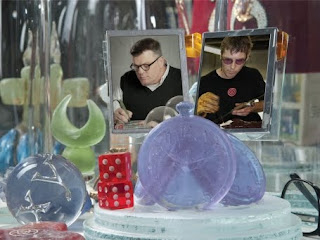
Tim has shown nationally and beyond, including exhibitions in the Museum of Arts and Design in New York; SOFA New York and Chicago; Art Basel Scope in Switzerland; Red Dot at Art Basel-Miami; the Luce Foundation Center for American Art at the Smithsonian; the Renwick Gallery and commercial galleries from Washington, DC to London and Berlin.
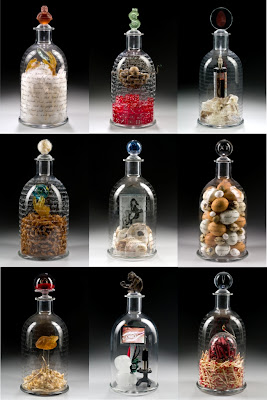
Tim Tate & Marc Petrovic
Apothecarium Moderne
photo: Anything Photographic
His awards include “Rising Star ” from the American, the Virginia Groot Foundation Award for Sculpture, three Artists Fellowship awards from the DC Commission on the Arts and Humanities and the Mayor’s Art Award. His work is in the permanent collections of the Smithsonian American Art Museum, Renwick Gallery, the Mint Museum, the Fuller Museum, the Katzen Art Center of American University, the Milwaukee Art Museum and Vanderbilt University. Tim Tate was just awarded a Fulbright, and in 2012, he will be at the UK’s University of Sunderland and the National Glass Centre. He has an upcoming solo show at the Taubman Museum in Roanoke, Va.
Click HERE to jump to the Taubman’s website information on the museum’s solo show “Tim Tate: The Waking Dreams of Magdalena Molière”
Washington Glass School: The First 10 Years
LongView Gallery
1234 9th Street, NW, Washington, DC
May 19 – June 19, Opening Reception, May 19th, 6:30-8:30 PM
For other glass artist profiles:
Diane Cabe
Sean Hennessey
Teddie Hathaway
Elizabeth Mears
Erwin Timmers
Michael Janis
Robert Kincheloe
Jackie Greeves
Jeff Zimmer
Allegra Marquart
If Its Tuesday, It Must Be Belgium
>
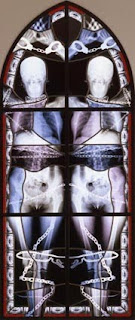
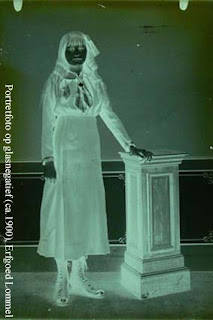
Michael Janis’ glass artwork is on exhibit at Belgium’s Glazen Huis as part of an international show titled “The Glass Canvas”, curated by J. Maes. The gallery exhibition is seen as a meeting between old and new in a glass context of religion, architecture, art and entertainment. The show contrasts historical glass artwork with contemporary glass work, from 14th and 16th century stained glass, 19th century glass photo negatives to work from current art glass leaders.
“This exhibition is an investigation into the use of glass as a canvas. It is a series of confrontations of the glass canvas in its physical appearance (smooth-rough light-dark transparent screen-reflection miniature-monumental), but also in the psychological experience (accessible-unreachable reveal-blur protect-invite). Going from the canvas as a mediator between inside and outside, to the glass surface as an image former or transformer, as a classical canvas or carrier of a concept that appears as a rigid skin or as a flexible weaving. The glass canvas presents itself as a breakable membrane that gives access to the unreachable reality, which it reflects or deforms, fragments or defragments.The glass canvas is a virgin surface that is covered with paints and emulsions or damaged by chemical or mechanical attacks, but in its clear state can be used as a high gloss protector.”
Artists exhibited : J.Schaechter [US], A.Salvador [IT], W.Berckmans [BE], M.Dukers [IT], F.Jespers [BE], F.Federer [GB], L.Semecka [CZ], S.Peretti [DE/US],M.Janis [US], R.Hawes [CA], N.Sandberg [US], T.Lahaie [US], J.Röder [DE], D.Sandersley [GB], K.Vanderstukken [BE/CA], I.Rosschaert [BE], M.Martens [BE], G.Pierson [BE], J.Caen [BE], E.Leibovitz [BE], W.Delvoye [BE].
‘The Glass Canvas – Glass as a canvas, as carrier through history’
April 10 – September 25, 2011
Het Glazen Huis
Flemish Center for Contemporary Glass Art
Dorp 14b, B-3920 Lommel, Belgium
http://www.hetglazenhuis.be/
Click here to jump to Glass Quarterly’s comments on “The Glass Canvas”
Glass Secessionism
The Internet and social network groups continue to create changes and offer options in art criticism and discussions. A new Facebook group “Glass Secessionism” has sprung up, creating a venue for artwork with a narrative or content-driven aesthetic.
According to the group description: The intent of this group is to underscore and define the 21st Century Sculptural Glass Movement and to illustrate the differences and strengths compared to late 20th century technique-driven glass. While the 20th century glass artists contributions have been spectacular and ground breaking, this group focuses on the aesthetic of the 21st century.
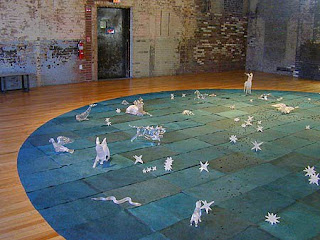
The object of the Glass-Secession is to advance glass as applied to sculptural expression; to draw together those glass artists practicing or otherwise interested in the arts, and to discuss from time to time examples of the Glass-Secession or other narrative work. This movement is modeled after Alfred Stieglitz and the Photo-Secessionists and how they redefined photography.
It was said of Stieglitz” What, then, was this secession from? It was not only from artwork that had gone stale through the copying of Victorian, conventional styles, but more importantly from the dictatorship of the entrenched institutions, galleries, art schools and professional art organizations that enforced or at very least sanctioned copying or imitation.”
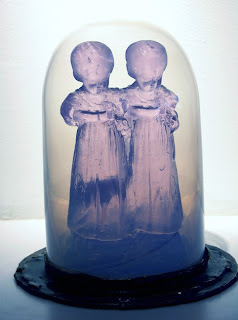 Stephen Paul Day & Sibelle Peretti
Stephen Paul Day & Sibelle PerettiKeep in mind, by Glass Secessionism it is not to say that we as artists are seceding from glass, just from the aesthetic of purely technique, material and process driven sculpture. There is no disrespect meant towards technique driven work. Glass Secessionism is a different branch of the glass tree. Think of them as separate but equal.
Glass Secessionism, with notable exceptions, is focused on 21st century sculptors in glass – and can include mixed and new media. There is a strong movement which begins at the graduate school level, to focus more on the narrative content and less on materiality. The newest emerging artists in glass tend to be much more focused on this direction.
 Christina Bothwell
Christina Bothwell
Glass is finally being allowed to be just another sculptural medium. The fine art world is certainly beginning to take notice, as so many notable fine art galleries and museums (not focused on glass in the past) are allowing and, in fact, promoting work and artists that are glass based.Members are encouraged to post and share their own or others examples of 21st century glass sculpture and open discussion topics regarding this issue. Click HERE to jump to the Facebook group.
Judith Schaechter Creativity Workshop
>
 The Sin Eater Glass 25 x 46 x 6 inches
The Sin Eater Glass 25 x 46 x 6 inches
As part of the James Renwick Alliance Distinguished Artist Series, Judith Schaechter will teach a Creativity Workshop on May 21, 2011. Designed to help artists explore ways to break through “artists block” and expand their creative practice, participants will engage in group discussions as well as individual exercises. On Sunday, May 22, Judith Schaechter will present a lecture on her work in the Grand Salon at the Renwick Gallery. The lecture will be free and open to the public.

Lockdown Glass 21 x 31 x 6 inches
Judith Schaechter, renowned stained glass artist, is the recipient of many grants, including the Guggenheim Fellowship, two National Endowment for the Arts Fellowships in Crafts, The Louis Comfort Tiffany Award, The Joan Mitchell Award, the Pew Fellowship in the Arts and a Leeway Foundation grant. Her work is in the collection of the Victoria and Albert Museum in London, the Philadelphia Museum of Art, The Corning Museum of Glass, The Smithsonian American Art Museum’s Renwick and numerous other collections. Judith’s work was included in the 2002 Whitney Biennial, and she is a 2008 USA Artists Rockefeller Fellow.
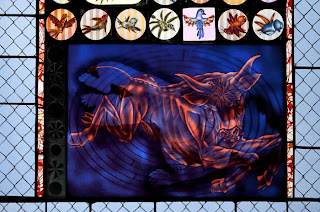 The Minotaur (detail) Glass 38 x 25 x 6 inches
The Minotaur (detail) Glass 38 x 25 x 6 inches
Creativity is mysterious, miraculous and utterly crucial to an artists’ practice. Because Judith Schaechter herself experienced some difficult bouts of artist’ block, she did a great deal of research into this fascinating and elusive subject. How does one become inspired? How does one choose the one idea to pursue amongst many ideas? Are there techniques to improve oneself creatively?
Ultimately, Judith divided creativity into the following: Inspiration, Perspiration (developing ideas into pieces), Practice (work habits, motivation), Audience and Beliefs.
This workshop will begin with a questionnaire, which should identify areas of interest to the participants. Judith will then share a presentation on what she has discovered. Lively group discussions and individual exercises will follow.
For more information or to register for any of these programs please e-mail: admin@jra.org

